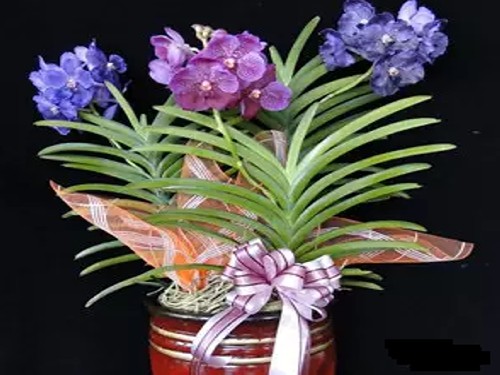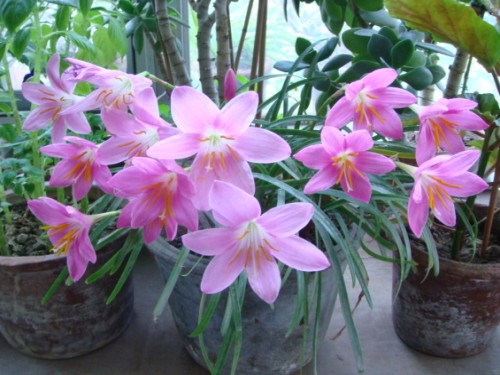Culture methods and maintenance points of Wandai orchid
The Wandai orchid in spring is about to enter the vigorous growth period, which is a good time to change the basin. Wandai orchid, which has been growing for many years, its root system will be tightly attached to the inner wall of the pot, so if it is planted in a pottery basin, it is best to break the basin and change the pot, so as not to damage the root system when taking out the plant. Wandailan is not only dignified and beautiful in appearance, but also tenacious in vitality, and can still reveal its fragrance under adverse conditions, so it was chosen as the national flower of Singapore. Next, the editor will introduce to you the breeding methods of Wandailan for your reference.

The culture methods of Wandailan:
Wandailan needs more fertilizer than other orchids, so during the period of vigorous growth, diluted fertilizer can be applied every 7 to 10 days. The best fertilizer is the ratio of nitrogen, phosphorus and potassium at 10:10:5. Because the roots of Wandailan are aerial roots, all media with good drainage can be applied, such as snake sawdust, broken bricks, charcoal, coarse gravel sand, etc., whether used alone or mixed, are good basin soil. In addition to the medium, the pots must also be very fastidious. In pots of various materials, wooden striped pots and pottery pots are the best, and a few more holes are pierced in the pots, which are more conducive to good drainage and air circulation. Wandailan can also grow well on snake boards or tree trunks. Wandailan should not change the basin frequently, unless it is disturbed by diseases and insect pests, it can be changed at least once every 3 years.
The Wandai orchid in spring is about to enter the vigorous growth period, which is a good time to change the basin. Wandai orchid, which has been growing for many years, its root system will be tightly attached to the inner wall of the pot, so if it is planted in a pottery basin, it is best to break the basin and change the pot, so as not to damage the root system when taking out the plant.
Finally, no matter how it is cultivated, keep in mind that the basin soil must be well drained and well ventilated.
The propagation of Wandai orchid can be done in tissue culture or high bud propagation, however, the former is not suitable for home because it requires more professional skills. At the end of autumn, Wandailan grows tall buds in the axils of the leaves. When the tall buds grow to 5~7.5cm, cut off the tall buds from the mother plant with a sharp and sterilized knife and plant them in a basin filled with snake sawdust, which can be transplanted to a larger basin. Remember to apply medicine on the incision to avoid being infected by germs.
In addition, when the plants cultivated for many years grow to more than 1m, you can cut off the terminal buds about 30~46cm, apply medicine to disinfect the incisions on both sides, and then plant them in a basin to keep them wet. The tough leaves of pest control are the main reason why Wandailan is not easy to suffer from diseases and insect pests. with the exception of snails and slugs, common pests are rarely found on strong orchid plants. However, when the water is retained in the leaves for too long, or infected by the virus, some dark markings or patches often appear, and gradually rot. If the condition is mild, the affected area can be removed. In case the range of decay is too wide, the whole orchid must be discarded so as not to infect other orchid plants.
Key points for the maintenance of Wandailan:
Perennial evergreen epiphytic herb. The flowers are large and colorful, and there are many varieties. At present, all the cultivated varieties are excellent hybrid varieties. Usually planted with four-wall porous flowerpots or wooden boxes, hanging in the greenhouse; using charcoal, broken bricks and so on as the matrix. The root is required to have excellent air permeability, like high temperature and humidity, and the normal growth temperature is above 20 ℃. Like plenty of sunshine, shade 30% and 50% in greenhouse cultivation in the north. Maintain high air humidity. Fertilizer was sprayed on the leaves every 1-2 weeks during the growing period. Spray water on the plant once or twice a day.
1. Placement position
Wandailan requires high temperature, high humidity and strong sunlight, and should be placed in a bright place (but not in direct sunlight) at all times. If possible, artificial light is needed in winter.
2. Temperature
Wandai orchid is suitable for cultivation in tropical areas, and it needs to be planted in high temperature greenhouse in the north, and the room temperature should be kept above 20 ℃.
3. Watering
Wandailan needs a lot of watering, never let the pot soil dry, but don't let the flowerpot soak in water.
4. Fertilization
At every other watering, Wandailan should add 50% concentration of standard liquid fertilizer.
5. Cultivation and changing pots
When planting, Wandailan should pay attention to the base of the stem can not be buried in the soil. Every spring, the seed is transferred to a large flowerpot, and when it is changed to the largest pot size, it can be cut for breeding.
Time: 2019-06-01 Click:
- Prev

Culture method of onion orchid
Green onion orchid, scientific name green onion lotus (Zephyranthescandida), also known as Yulian, green onion orchid and so on, perennial herbs. The whole herb with bulb is a kind of folk herbal medicine, which has the effect of calming the liver, calming the heart, extinguishing the wind and calming the wind. It is mainly used to treat infantile wind and epilepsy.
- Next

Culture methods and matters needing attention of night incense
Evening incense, we must be no stranger to this kind of flower, flower friends who like to listen to songs will know which song is directly named after this kind of flower. Nocturnal flowers are small, but their fragrance is very strong, so they are usually planted in the courtyard for viewing, and the breeding of nocturnal incense is relatively simple.
Related
- Fuxing push coffee new agricultural production and marketing class: lack of small-scale processing plants
- Jujube rice field leisure farm deep ploughing Yilan for five years to create a space for organic food and play
- Nongyu Farm-A trial of organic papaya for brave women with advanced technology
- Four points for attention in the prevention and control of diseases and insect pests of edible fungi
- How to add nutrient solution to Edible Fungi
- Is there any good way to control edible fungus mites?
- Open Inoculation Technology of Edible Fungi
- Is there any clever way to use fertilizer for edible fungus in winter?
- What agents are used to kill the pathogens of edible fungi in the mushroom shed?
- Rapid drying of Edible Fungi

